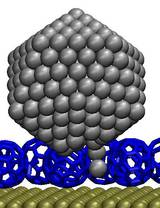Home > Press > Using Fullerenes as a ‘Cushion’ for Nanoparticles
 |
Abstract:
Physicists reveal a new mechanism important for the stability of nano-composites TU Dortmund, Universität Freiburg and Fraunhofer-Institut für Werkstoffmechanik IWM
Using Fullerenes as a ‘Cushion’ for Nanoparticles
Germany | Posted on May 1st, 2010Nanoparticles are recognized as promising building blocks for future applications, however their fixation on surfaces or in a matrix is everything else than a simple task. Now physicists observed that a double layer of spherical C60 carbon-molecules, called fullerenes, is an ideal substrate for these microscopic particles. Their results, recently published in Nature Nanotechnology, are an important step towards the application of tailor-made nanosystems.
The properties of nanoparticles often differ from those of a large piece made of the same material. By tuning the size and composition of the nanoparticles, one can ‘tailor' their chemical, optical or magnetic properties, and obtain features different from any bulk material. But for an application of this potential in the fields of catalysis, magnetic storage technology or optoelectronics, one has to fix the nanoparticles on surfaces or in matrixes. During this process the interaction with the surface or matrix at the worst destroys the unique properties of the nanoparticles.
Therefore it is important to develop techniques for a ‘gentle' yet secure fixation of nanoparticles. This was now achieved by a team of physicists from the TU Dortmund, the University of Freiburg and the Fraunhofer Institute for Mechanics of Materials IWM, who deposited the particles on a layer of spherical C60 carbon-molecules, called fullerenes, and investigated their properties.
They showed that a double layer of fullerenes on a metal surface is an ideal substrate for the fixation of nanoparticles. The size and shape of the particles stayed unchanged for days even at room temperature, which is ‘hot' for nanoscale processes. On a single layer of fullerenes, however, the particles shrank fast and disappeared within a few hours. Using atomic simulations this was traced back to temporary contacts bridging the fullerene layer and transporting atoms from the nanoparticles to the supporting metal surface.
On the basis of these results it might be possible, for example, to control the contact between nanoparticles by thin films which can either be penetrated or stay isolating. The scientists therefore not only demonstrated how to fix nanoparticles on surfaces without destruction of their geometric structure, but in particular they characterized a decay process for nanoparticles by the penetration of nanoscopic barriers in detail. These findings improve significantly the understanding of nanoparticle stability, which is an important step towards the application of tailor-made nanosystems.
Publication:
Stefanie Duffe, Niklas Grönhagen, Lukas Patryarcha, Benedikt Sieben, Chunrong Yin, Bernd von Issendorff, Michael Moseler and Heinz Hövel: Penetration of thin C60 films by metal nanoparticles, Nature Nanotechnology published online April 2010, DOI: 10.1038/NNANO.2010.45
####
For more information, please click here
Contacts:
Heinz Hövel (corresponding author)
Experimentelle Physik I
TU Dortmund
44221 Dortmund, Germany
phone: +49 231 755 3521
fax: +49 231 755 3657
TU Dortmund
Bernd von Issendorff
Physikalisches Institut
Universität Freiburg
Michael Moseler
Physikalisches Institut
Universität Freiburg and
Fraunhofer Institut für Werkstoffmechanik IWM
Copyright © Fraunhofer Institute for Mechanics of Materials IWM
If you have a comment, please Contact us.Issuers of news releases, not 7th Wave, Inc. or Nanotechnology Now, are solely responsible for the accuracy of the content.
| Related News Press |
News and information
![]() Simulating magnetization in a Heisenberg quantum spin chain April 5th, 2024
Simulating magnetization in a Heisenberg quantum spin chain April 5th, 2024
![]() NRL charters Navy’s quantum inertial navigation path to reduce drift April 5th, 2024
NRL charters Navy’s quantum inertial navigation path to reduce drift April 5th, 2024
![]() Discovery points path to flash-like memory for storing qubits: Rice find could hasten development of nonvolatile quantum memory April 5th, 2024
Discovery points path to flash-like memory for storing qubits: Rice find could hasten development of nonvolatile quantum memory April 5th, 2024
Possible Futures
![]() Discovery points path to flash-like memory for storing qubits: Rice find could hasten development of nonvolatile quantum memory April 5th, 2024
Discovery points path to flash-like memory for storing qubits: Rice find could hasten development of nonvolatile quantum memory April 5th, 2024
![]() With VECSELs towards the quantum internet Fraunhofer: IAF achieves record output power with VECSEL for quantum frequency converters April 5th, 2024
With VECSELs towards the quantum internet Fraunhofer: IAF achieves record output power with VECSEL for quantum frequency converters April 5th, 2024
Nanotubes/Buckyballs/Fullerenes/Nanorods/Nanostrings
![]() Tests find no free-standing nanotubes released from tire tread wear September 8th, 2023
Tests find no free-standing nanotubes released from tire tread wear September 8th, 2023
![]() Detection of bacteria and viruses with fluorescent nanotubes July 21st, 2023
Detection of bacteria and viruses with fluorescent nanotubes July 21st, 2023
Announcements
![]() NRL charters Navy’s quantum inertial navigation path to reduce drift April 5th, 2024
NRL charters Navy’s quantum inertial navigation path to reduce drift April 5th, 2024
![]() Discovery points path to flash-like memory for storing qubits: Rice find could hasten development of nonvolatile quantum memory April 5th, 2024
Discovery points path to flash-like memory for storing qubits: Rice find could hasten development of nonvolatile quantum memory April 5th, 2024
|
|
||
|
|
||
| The latest news from around the world, FREE | ||
|
|
||
|
|
||
| Premium Products | ||
|
|
||
|
Only the news you want to read!
Learn More |
||
|
|
||
|
Full-service, expert consulting
Learn More |
||
|
|
||








